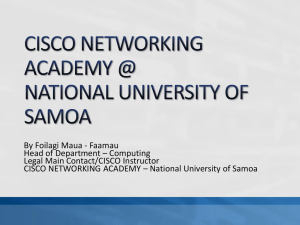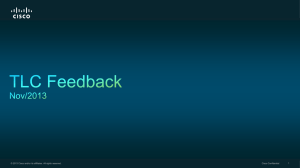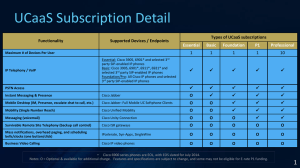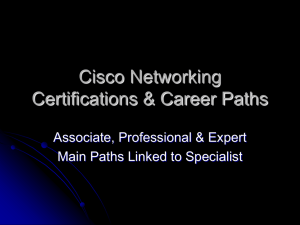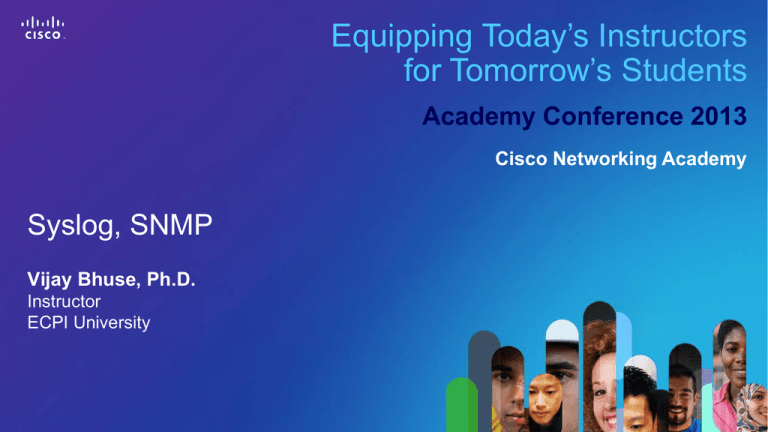
Equipping Today’s Instructors
for Tomorrow’s Students
Academy Conference 2013
Cisco Networking Academy
Syslog, SNMP
Vijay Bhuse, Ph.D.
Instructor
ECPI University
Cisco Networking Academy, U.S./Canada
© 2013 Cisco Systems, Inc. All rights reserved. Cisco confidential.
1
• SNMP is an application layer protocol that provides a message
format for communication between what are termed managers and
agents
• Components include
• SNMP manager
• SNMP agent
• Management Information Base
Cisco Networking Academy, U.S./Canada
© 2013 Cisco Systems, Inc. All rights reserved. Cisco confidential.
2
• Get
• Set
• Trap - unreliable
• Trap (SNMPv3 uses ACK) - reliable
Cisco Networking Academy, U.S./Canada
© 2013 Cisco Systems, Inc. All rights reserved. Cisco confidential.
3
Cisco Networking Academy, U.S./Canada
© 2013 Cisco Systems, Inc. All rights reserved. Cisco confidential.
4
Cisco Networking Academy, U.S./Canada
© 2013 Cisco Systems, Inc. All rights reserved. Cisco confidential.
5
Cisco Networking Academy, U.S./Canada
© 2013 Cisco Systems, Inc. All rights reserved. Cisco confidential.
6
• MIB defines each variable as an object ID (OID)
• Organizes the into a hierarchy of OIDs, usually shown as a tree
• MIB for any device includes some branches of the tree with variables
common to many networking devices and branches with variables
specific to that device.
• Networking equipment vendors like Cisco can define their own private
branches of the tree
Cisco Networking Academy, U.S./Canada
© 2013 Cisco Systems, Inc. All rights reserved. Cisco confidential.
7
Cisco Networking Academy, U.S./Canada
© 2013 Cisco Systems, Inc. All rights reserved. Cisco confidential.
8
-v2c The version on SNMP in use
-c community The SNMP password, called a community string
10.250.250.14 The IP address of the monitored device
1.3.6.1.4.1.9.2.1.58.0 The numeric object identifier (OID) of the MIB variable
Cisco Networking Academy, U.S./Canada
© 2013 Cisco Systems, Inc. All rights reserved. Cisco confidential.
9
There are two types of community strings in SNMP Version 2c:
• Read-only (RO): Provides access to the MIB variables, but does not
allow these variables to changed, only read. Because security is so
weak in Version 2c, many organizations only use SNMP in this readonly mode.
• Read-write (RW): Provides read and write access to all objects in the
MIB.
Cisco Networking Academy, U.S./Canada
© 2013 Cisco Systems, Inc. All rights reserved. Cisco confidential.
10
R1(config)# ip access-list standard ACL_PROTECTSNMP
R1(config-std-nacl)# permit host 10.10.10.101
R1(config-std-nacl)# exit
R1(config)# snmp-server community V011eyB@11!!! RO ACL_PROTECTSNMP
R1(config)# snmp-server location Tampa
R1(config)# snmp-server contact Anthony Sequeira
R1(config)# end
R1#
Cisco Networking Academy, U.S./Canada
© 2013 Cisco Systems, Inc. All rights reserved. Cisco confidential.
11
R2(config)# ip access-list standard ACL_PROTECTSNMP
R2(config-std-nacl)# permit host 10.20.20.201
R2(config-std-nacl)# exit
R2(config)# snmp-server community T3nn1sB@ll RW ACL_PROTECTSNMP
R2(config)# snmp-server location New York
R2(config)# snmp-server contact John Sequeira
R2(config)# end
R2#
Cisco Networking Academy, U.S./Canada
© 2013 Cisco Systems, Inc. All rights reserved. Cisco confidential.
12
• Message integrity: This helps ensure that a packet has not been
tampered with in transit
• Authentication: This helps ensure that the packet came from a
known and trusted source
• Encryption: This helps to ensure that information cannot be read if
the data is captured in transit
Cisco Networking Academy, U.S./Canada
© 2013 Cisco Systems, Inc. All rights reserved. Cisco confidential.
13
Cisco Networking Academy, U.S./Canada
© 2013 Cisco Systems, Inc. All rights reserved. Cisco confidential.
14
• Syslog permits various Cisco devices (and some other non-Cisco
devices) to send their system messages across the network to syslog
servers
• You can even build a special out-of-band (OOB) network for this
purpose
• There are many different Syslog server software packages for
Windows and UNIX
Cisco Networking Academy, U.S./Canada
© 2013 Cisco Systems, Inc. All rights reserved. Cisco confidential.
15
• The logging buffer (RAM inside the router or switch)
• The console line
• The terminal lines
• A syslog server
Cisco Networking Academy, U.S./Canada
© 2013 Cisco Systems, Inc. All rights reserved. Cisco confidential.
16
Cisco Networking Academy, U.S./Canada
© 2013 Cisco Systems, Inc. All rights reserved. Cisco confidential.
17
• A timestamp: *Dec 18 17:10:15.079
• The facility on the router that generated the message: %LINEPROTO
• The severity level: 5
• A mnemonic for the message: UPDOWN
• The description of the message: Line protocol on Interface
FastEthernet0/0, changed state to down
Cisco Networking Academy, U.S./Canada
© 2013 Cisco Systems, Inc. All rights reserved. Cisco confidential.
18
Cisco Networking Academy, U.S./Canada
© 2013 Cisco Systems, Inc. All rights reserved. Cisco confidential.
19
Cisco Networking Academy, U.S./Canada
© 2013 Cisco Systems, Inc. All rights reserved. Cisco confidential.
20
• R1(config)#logging 192.168.1.101
• R1(config)#logging trap 4
• By default, Cisco routers and switches send log messages
for all severity levels to the console. On some IOS versions,
the device also buffers those log messages by default
• R1(config)# logging console
• R1(config)# logging buffered
• R1# show logging
Cisco Networking Academy, U.S./Canada
© 2013 Cisco Systems, Inc. All rights reserved. Cisco confidential.
21
• Wendell Odom, "Cisco CCNA Routing and Switching ICND2 200-
101 Official Cert Guide", Cisco Press, May 14, 2013.
Cisco Networking Academy, U.S./Canada
© 2013 Cisco Systems, Inc. All rights reserved. Cisco confidential.
22
Cisco Networking Academy, U.S./Canada
© 2013 Cisco Systems, Inc. All rights reserved. Cisco confidential.
23



